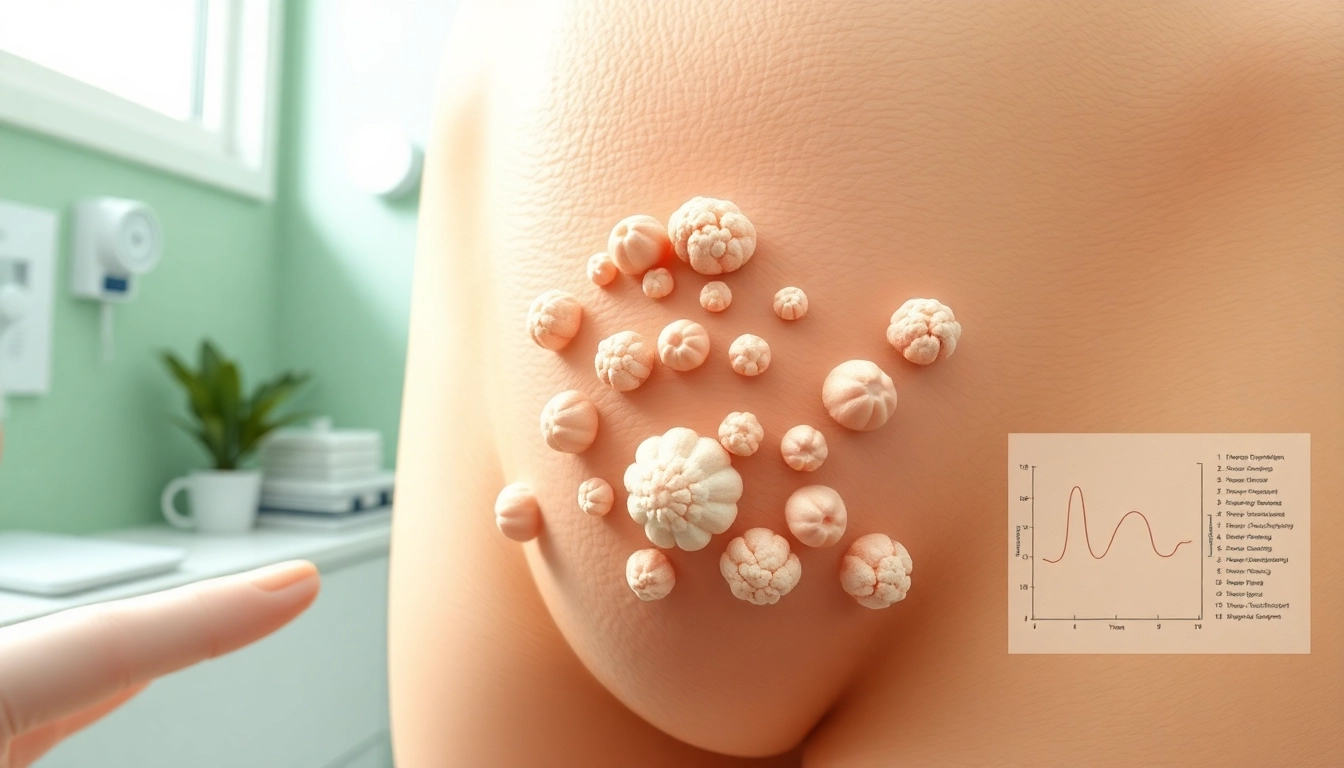What are Anal Warts?
Definition and Overview
Anal warts, also known medically as condyloma acuminata, are benign growths that occur around the anus and within the anal canal. They are primarily caused by specific strains of the human papillomavirus (HPV), which is a common sexually transmitted infection. While anal warts can appear as small, smooth bumps or larger, cauliflower-like clusters, they are often flesh-colored and can be asymptomatic in some cases. However, many individuals may experience discomfort, itching, or irritation resulting from the lesions. Understanding the causes, symptoms, and available treatments is crucial for effective management of this condition.
Causes of Anal Warts
The primary cause of anal warts is infection with HPV, particularly types 6 and 11, which are known to be responsible for 90% of genital wart cases. HPV can be transmitted through Anal warts sexual contact, including vaginal, anal, and oral sex, or even through skin-to-skin contact with an area where the virus is present. The virus can lie dormant for years, making it difficult for individuals to know they are infected. A weakened immune system, resulting from factors like stress or illness, may also contribute to the likelihood of developing warts.
Transmission and Risk Factors
Anal warts are highly contagious, and several factors can increase the risk of transmission. Engaging in unprotected sexual activities, having multiple sexual partners, or being in a relationship where one partner has warts heightens susceptibility. Additionally, researchers have identified behaviors like anal intercourse or the presence of other sexually transmitted infections (STIs) as significant risk factors. Men who have sex with men or individuals with compromised immune systems, such as those with HIV, are also at an increased risk of contracting HPV and developing anal warts.
Symptoms of Anal Warts
Common Symptoms to Recognize
Most individuals with anal warts may not experience noticeable symptoms; however, several signs can indicate their presence. These symptoms include:
- Small, flesh-colored bumps or clusters of bumps appearing around the anus.
- Itching or irritation in the anal area.
- Bleeding during bowel movements.
- Discomfort or pain, particularly during anal intercourse.
If left untreated, the growths may increase in size and number, which can lead to further discomfort and complications.
When to Seek Medical Attention
It is essential to consult a healthcare provider if you notice any unusual growths or persistent symptoms around the anus. Individuals should seek medical attention if they experience:
- Heavy bleeding or significant pain.
- Warts that change in appearance or texture.
- Difficulty with bowel movements.
- New warts appear despite previous treatment.
Timely intervention from a healthcare provider can help manage symptoms effectively and prevent further complications.
Associated Conditions
Often, anal warts may occur alongside other conditions, particularly in those who have HPV. Some associated conditions to be aware of include:
- Anal dysplasia: Abnormal changes in the cells of the anal area, which may increase the risk of cancer.
- Other types of genital warts that can occur in the nearby genital region.
- Other STIs, including herpes or gonorrhea, which can complicate diagnosis and treatment.
Diagnosis of Anal Warts
Physical Examination Process
A visual inspection by a healthcare professional is often the first step in diagnosing anal warts. The provider will examine the anal region for warts, growths, or abnormal tissue. This examination is usually quick and involves minimal discomfort. In some cases, if warts are not visible, further diagnostic procedures may be necessary.
Diagnostic Tests and Procedures
In addition to a physical examination, healthcare providers may use several diagnostic methods to confirm the presence of anal warts:
- Anoscopy: A procedure that involves inserting a small, tubular instrument to visually inspect the inside of the anal canal.
- Pap smear: For individuals at higher risk of anal cancer, a pap smear can check for precancerous changes in anal cells.
- Biopsy: In rare cases, taking a small tissue sample for laboratory analysis may be necessary to rule out other conditions.
Understanding Differential Diagnosis
It is crucial to distinguish anal warts from other conditions with similar symptoms, such as:
- Hemorrhoids: Swollen veins in the anal region that can also cause pain and bleeding.
- Fissures: Small tears in the anal lining that can lead to discomfort and bleeding.
- Other skin growths or cancers: Recognizing the differences between benign growths and potential malignancies is essential for appropriate treatment.
Treatment Options for Anal Warts
Over-the-Counter Treatments
For mild cases of anal warts, over-the-counter topical treatments might be effective. Many of these products contain salicylic acid, which helps peel away the wart tissue. Regular application may reduce the size and number of growths. However, consulting with a healthcare provider before beginning any treatment is advisable, particularly for delicate areas such as the anal region.
Prescription Medications
If over-the-counter options do not provide relief, healthcare providers may prescribe stronger topical treatments, such as:
- Imiquimod (Aldara): This immune response modifier boosts the immune system’s ability to fight the HPV virus.
- Podophyllin and Podofilox: Derived from the mayapple plant, these treatments are specific to wart tissue and are often effective.
Patients should follow their healthcare provider’s instructions carefully to ensure safe application and maximum effectiveness.
Surgical Procedures and Alternatives
In cases where warts are extensive or unresponsive to medical treatment, several surgical options may be considered. These include:
- Cryotherapy: Freezing warts using liquid nitrogen can effectively kill wart tissue.
- Electrosurgery: This technique uses electrical currents to burn off warts.
- Laser treatment: Laser therapy can be effective for larger clusters or those resistant to other treatments.
Healthcare providers will work with patients to determine the best approach based on individual circumstances and the extent of the condition.
Prevention and Management
Preventative Measures
Preventing anal warts revolves primarily around minimizing HPV transmission and reducing risk factors. Consider the following measures:
- Use condoms during sexual activity to reduce the transmission of HPV.
- Engage in monogamous relationships to limit exposure to the virus.
- Get vaccinated against HPV, which can protect against the strains that cause most warts and related cancers.
Living with Anal Warts
Life with anal warts can be challenging, but many people find ways to manage their condition effectively. Regular communication with healthcare providers can help individuals navigate treatment options and address any complications. Additionally, joining support groups or seeking counseling can provide emotional support and practical advice for coping with symptoms.
Myths and Facts About Anal Warts
Despite the prevalence of anal warts, several myths and misconceptions persist. Clarifying these points can help individuals make informed decisions about their health:
- Myth: Only sexually active individuals get anal warts. Fact: While sexually transmitted, anyone can become infected with HPV.
- Myth: Anal warts always come with severe symptoms. Fact: Many people experience no symptoms at all.
- Myth: Anal warts can turn into cancer in all cases. Fact: Most anal warts are benign, though they can be associated with a higher risk of anal cancer without appropriate management.



